Menus
- Mountains of torque
- Endless series of simulations and experiments
- Power and torque of the H2 four-cylinder with an almost linear increase
- Torque and power curves not just the printout of measured values
- Kawasaki Ninja H2 feels very different
- H2 wants to be brought on course with care
- Ducati 1299 Panigale S weighs 194 kilograms with a full tank
- Both bikes with Brembo braking systems
- Technical specifications
- Readings
- Performance measurements
- Further measurements
- Conclusion
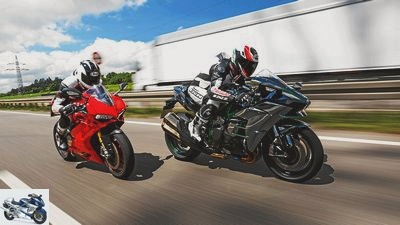
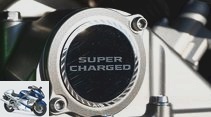
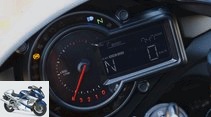
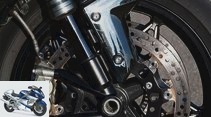
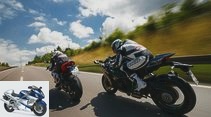
31 photos
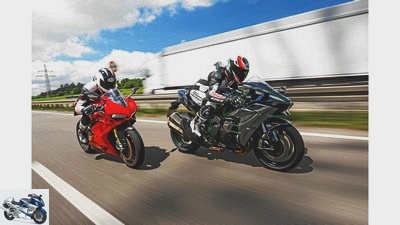
1/31
On the left in the picture 197 PS and 145 Nm (Ducati 1299 Panigale S), on the right there are 200 PS and 133 Nm (Kawasaki Ninja H2).
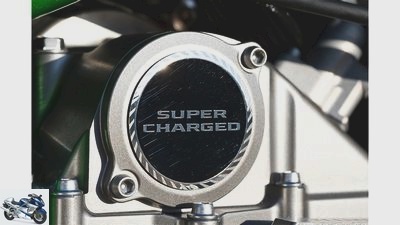
2/31
For those who can’t see the compressor inflate their cheeks for themselves, there’s a hint.
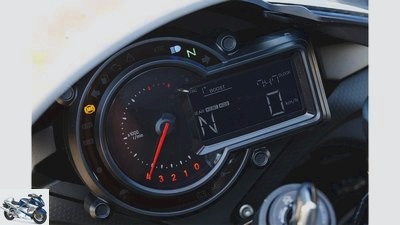
3/31
While the cockpit is more conventional and economical …
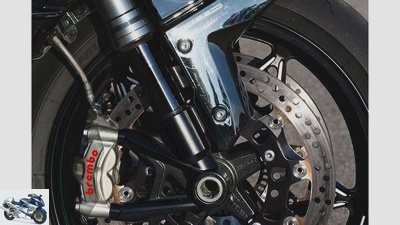
4/31
… are the finest fork and brake.
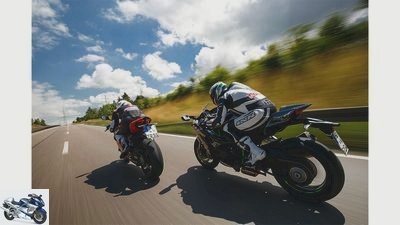
5/31
Ducati 1299 Panigale S and Kawasaki Ninja H2.
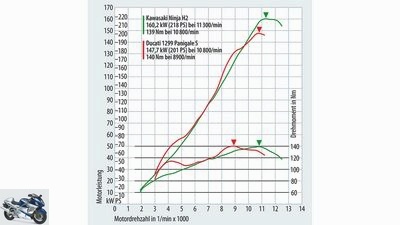
6/31
An expression of motor power: thanks to the larger displacement, fuller from the start, with an initial peak from 4000 rpm, which provides tremendous thrust from slow corners, the Ducati’s torque curve builds up. The Kawasaki distinguishes itself with an almost perfectly linear relationship between increasing engine power and speed. At first it can be confused and then tears more and more. On the final ascent to the peak of performance, the Kawasaki rider has to be careful not to lose sight or hearing. But one thing is clear: Anyone who hangs around up there did not want it any other way.
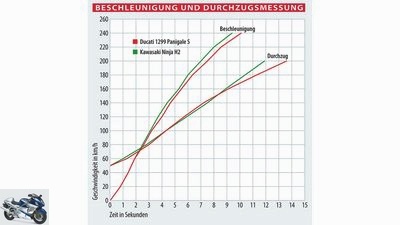
7/31
And the traction curves explain how the curves for acceleration and traction come about …
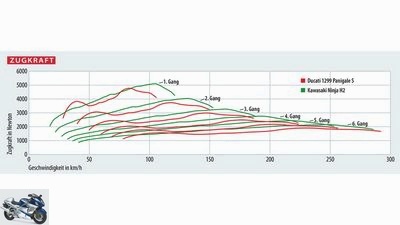
8/31
What an engine produces in terms of power and torque only makes up part of its dynamics. The pulling force diagram shows the force acting on the rear tire.
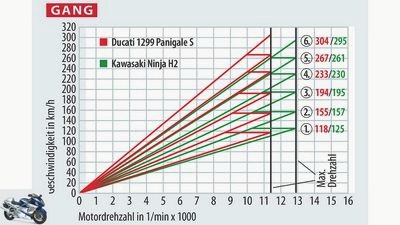
9/31
… From second gear, the H2 puts more power on the rear wheel than the Panigale, and this advantage comes into play beyond 100 km / h.
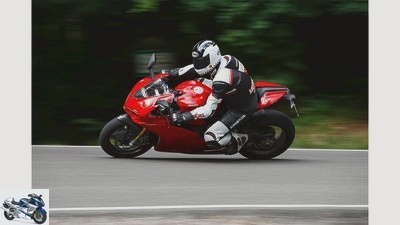
10/31
Ducati 1299 Panigale S..
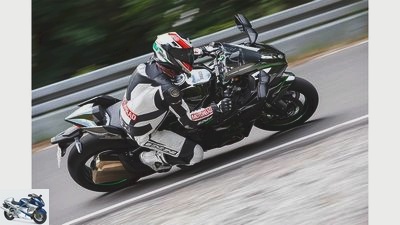
11/31
Kawasaki Ninja H2.
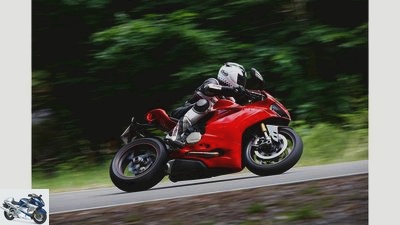
12/31
Ducati 1299 Panigale S..
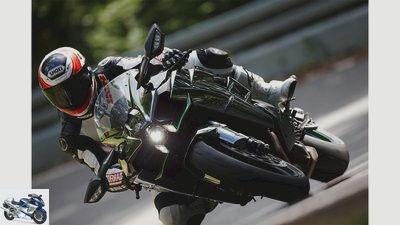
13/31
Kawasaki Ninja H2.
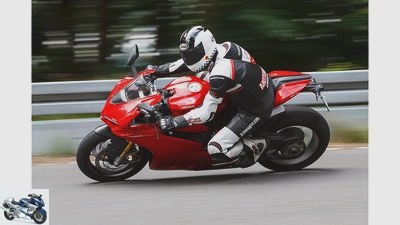
14/31
Ducati 1299 Panigale S..

15/31
Anyone who thinks that four-cylinder in-line cylinders are boring is not understanding the performance and high-quality architecture of the H2 engine.
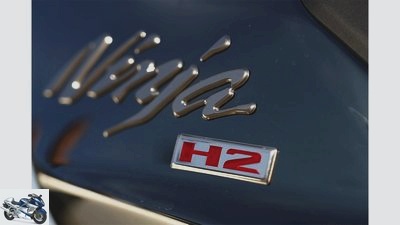
16/31
Kawasaki Ninja H2.
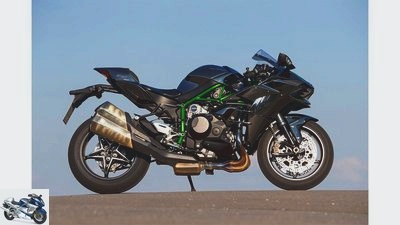
17/31
Kawasaki Ninja H2.
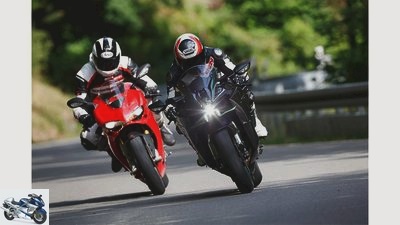
18/31
Both bikes can therefore inspire with breathtaking torques. In order to achieve this, however, they go very different ways.
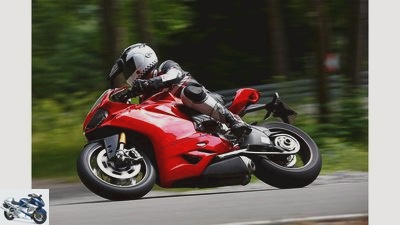
19/31
The Ducati 1299 Panigale S generates the immense torque through the explosion of as much mixture as possible, which pushes the huge 116 piston down.
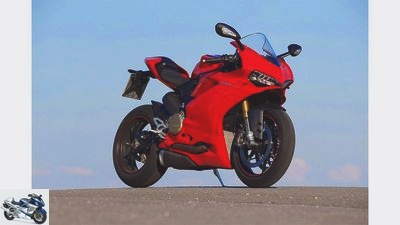
20/31
Ducati 1299 Panigale S..
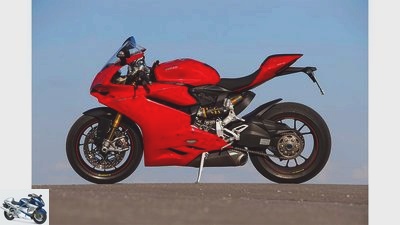
21/31
Ducati 1299 Panigale S..
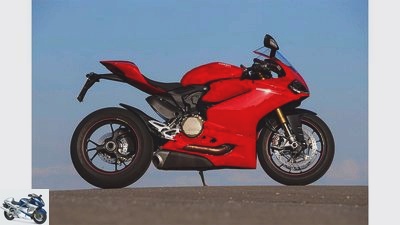
22/31
Ducati 1299 Panigale S..
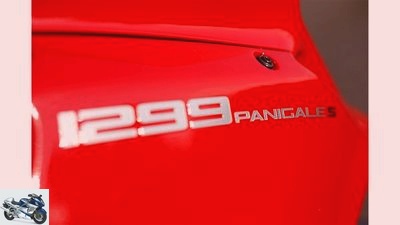
23/31
Ducati 1299 Panigale S..
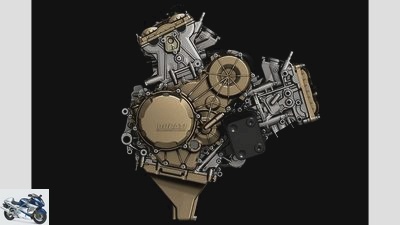
Ducati
24/31
A radical sports engine: the housing walls fit the inner parts like a skin, ribs ensure rigidity and low weight. And by the way: The V is formed by the cylinder heads, the ultra-short stroke hardly allows the short pistons to protrude beyond the housing.
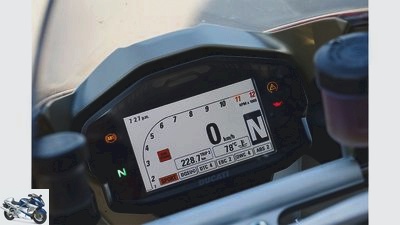
25/31
The lower bar of the cockpit provides information about the electronic driving aids, …
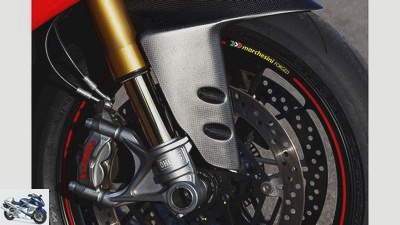
26/31
… the brake has a hard time working.
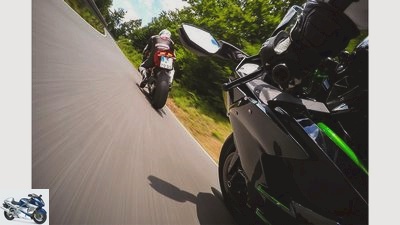
27/31
Ducati 1299 Panigale S and Kawasaki Ninja H2.
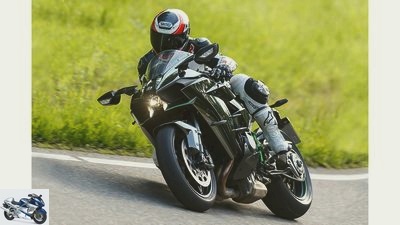
28/31
Kawasaki’s Ninja H2 achieves its torque with the help of a compressor that uses a compressor wheel to generate overpressure in the intake track.
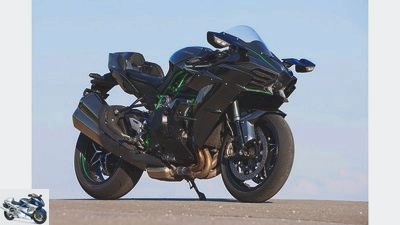
29/31
Kawasaki Ninja H2.
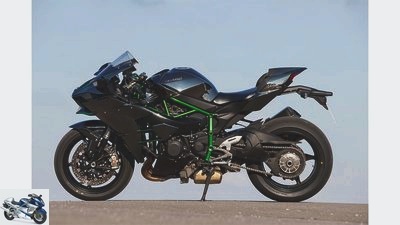
30/31
Kawasaki Ninja H2.
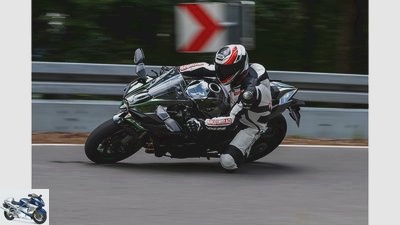
31/31
Kawasaki Ninja H2.
Ducati 1299 Panigale S and Kawasaki Ninja H2 in comparison test
Mountains of torque
The torque curves of the two test motorcycles reach lonely heights. As a “climbing aid”, the Ducati 1299 Panigale S uses a radical engine concept and increased displacement, the Kawasaki Ninja H2 a compressor. This comparison shows how different what is on the same level can be.
Kraft times lever arm. This is the definition of torque, and everyone has probably already experienced how he can generate enormous torque with a relatively small force on a long lever. For this reason, motors with a long stroke, which can be equated with the lever arm, are particularly high-torque.
Buy complete article

Ducati 1299 Panigale S and Kawasaki Ninja H2 in comparison test
Mountains of torque
Ducati 1299 Panigale S generates a very high torque in the other possible way: it works with great force acting on an extremely short stroke. Its developers have optimized the combustion pressure, which drives the huge 116 pistons down after the gasoline-air mixture ignites. They do this by transporting as much mixture as possible into the combustion chambers via wide channels and large valves.
Endless series of simulations and experiments
In addition, the Ducati-typical desmodromic valve control, in which the closing of the valves is not done by springs, but by closing cams, ensures that the valves function efficiently: They are only kept on their seat by weak auxiliary springs, they are really hammered open and closed, so they are needed by from the closed position to the maximum stroke less time than with “spring motors”.
So much for the structural fundamentals. The remainder, which is anything but insignificant, consists of a seemingly endless series of simulations and experiments to determine the best possible control times, ignition times, injection times and quantities, to optimally shape the vibration conditions in the engine and its peripherals. It is probably these vibration conditions, which are determined by the airbox, the intake funnels, the ducts, the valve timing and the exhaust system, that give the Ducati 1299 Panigale S engine its two camel humps in the torque curve. At least one notices that the second hump bulges almost exactly at twice the speed of the first, in the octave if you will. This circumstance usually points to vibration phenomena as the cause.
Power and torque of the H2 four-cylinder with an almost linear increase
In contrast, the power and torque of the H2 four-cylinder increase almost linearly, and that seems to exemplify the difference between engines with mechanical turbochargers and naturally aspirated engines. Because with the supercharged engine of the Kawasaki Ninja H2, the overpressure generated by a compressor wheel in the intake tract has a decisive influence on the performance; Vibrations, which ensure a particularly high degree of filling in certain speed ranges, play a subordinate role. The overpressure increases proportionally with the speed, and that is one reason for the exemplary shape of the torque and power curves, which should actually be called torque and power straight lines.
When driving the Kawasaki Ninja H2, however, one also gets the impression that the electronically controlled “blow off” valve in the lower engine speed range delays the build-up of the boost pressure somewhat so as not to generate too much torque too quickly. It is possible that the turbocharger also builds up flow resistance at low speeds and can only provide more power when its speed approaches 100,000 rpm; with the 1:18 ratio only from a crankshaft speed of around 5000 rpm.
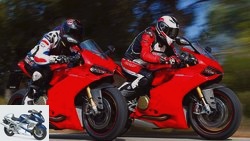
Super athlete
Ducati 1299 Panigale S and Ducati 1199 Panigale S in comparison test
What can the new one do better??
read more
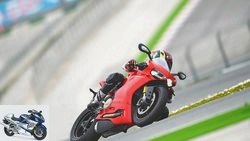
Super athlete
Ducati 1299 Panigale S in the driving report
Sports cannon through and through
read more
All tests and articles about the Ducati 1299 Panigale S.
Torque and power curves not just the printout of measured values
Either way, the torque and power curves of the Kawasaki Ninja H2 and the Ducati 1299 Panigale S are not just the expression of measured values. Those with some experience can use these curves to imagine exactly how the propulsion begins. The Ducati gets going spontaneously and with power. There are few motorcycle engines that weigh 114 Newton meters on the crankshaft at 4000 rpm and, thanks to their low weight and low flywheel mass, convert them into acceleration as vehemently as the Panigale V2. He almost clicks through the rev range. The thrust comes almost like a raid, is constantly present and can be woken up with a light tug on the throttle grip.
In connection with so much motor power, such a characteristic can only be tamed with sophisticated electronic driving aids. Even with a sensitive driving style on the country road, you can often feel how the traction control of the Ducatz 1299 Panigale S holds back part of the torque delivery when exiting a curve. Very often you are in the speed range of the first camel hump.
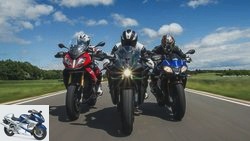
Naked bike
Aprilia Tuono V4 1100 RR, Kawasaki Ninja H2 and BMW S 1000 XR in the comparison test
A colorful trio
read more
All tests and articles about the Kawasaki Ninja H2
Kawasaki Ninja H2 feels very different
The Kawasaki feels completely different. The H2 generally wants to be driven at higher speeds than the Ducati. That is why the developers of the Kawasaki Ninja H2 have adapted a transmission with comparatively short lower gears to their flagship and also designed the overall ratio to be rather short. The term “comparatively” does not refer to the Ducati, which has a similar translation because of its not so high-revving engine, but to other high-revving four-cylinders. The short gear ratios of the H2 increase the effective pulling force on the rear wheel, so that the Ducati 1299 Panigale S can only reach or even surpass it in the area of the camel humps mentioned. Which in turn is largely offset by the significantly lower weight of the Panigale when accelerating, as the acceleration values in the lower speed range show.
The measured values from the dynamometer as well as the pull-through test give an idea of what happens when the four-cylinder of the Kawasaki Ninja H2 turns higher and higher. Then the initially subtle thrust swells into a huge current that carries you along like a catapult. Beyond 200 km / h, the extra power of the H2 comes into its own, and it irresistibly hurries the Ducati 1299 Panigale S..
H2 wants to be brought on course with care
This is not the ideal characteristic for sprinting from corner to corner, especially since the load changes on the Kawasaki Ninja H2 rarely succeed without a powerful punch in the drive train. And although the compressor follows the engine speed without delay, there seems to be a slight delay in the build-up of pressure, especially with frequent load changes. The H2 can only offer its full experience value with a lot of free space in front of the front wheel.
The design of the chassis of the Kawasaki Ninja H2 matches this. With a long wheelbase and caster, a comparatively flat steering head – half a degree to or fro does a lot – as well as high weight and a lot of load on the front wheel, it doesn’t have to deal with easy turning and jagged lean changes. It wants to be carefully brought on course, but it can hardly be shaken by crests or bumps up to top speed. You can literally feel the respect of the Japanese engineers for the unlimited German highways. Your motorcycle should never swing or hit the handlebars, not even in the beginning.
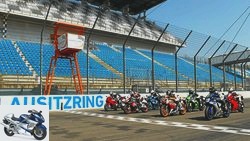
Super athlete
Seven super athletes in the track test
Part 1 comparison test on the racetrack
read more
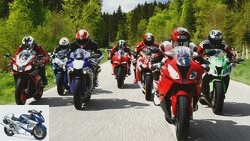
Super athlete
Seven sports motorcycles in the country roads classification
Part 2 comparison test on the country road
read more
Ducati 1299 Panigale S weighs 194 kilograms with a full tank
Are you not exaggerating a little? This question arises when driving the Ducati 1299 Panigale S. At 194 kg, the Italian is the lightest, even among her own kind. You can tell that Ducati boss Claudio Domenicali is still following the maxim of his mentor Franco Farnè: “If you want to make a motorcycle light, make sure that every single part is lighter than its predecessor.” The wheelbase is that Panigale is relatively long for a super sports car, but the combination of short caster, steep steering head and extremely low weight gives it a dreamy lightness. In contrast to the baroque abundance of the Kawasaki Ninja H2, it looks extremely slim and well-trained, its high steering precision is impressive. Even so, the Panigale runs perfectly straight at high speed. It doesn’t even hurt that their tightly tuned suspension elements sometimes react rough on bumps.
Despite the presence of its engine in almost all speed and life ranges and its outstanding handling qualities, i.e. despite some virtues relevant to everyday life, the Ducati 1299 Panigale S is not a good everyday motorcycle. The engine’s smooth running leaves too much to be desired. This shows the downside of the low centrifugal mass. On the one hand, it favors the fulminant revving of the V2, but on the other hand ensures strong wow and flutter at low speeds. These manifest themselves through constant rumbling, shaking and constant jerking. The high mechanical noise level, which is only slightly dampened by the thin, weight-optimized housing walls, also helps the driver to go to the engine speed range above 6000 rpm wherever possible; Highway speed in sixth gear is a constant torment for driver and machine, especially under load.
Both bikes with Brembo braking systems
A four-cylinder that ignites twice as often as a two-cylinder has an advantage in terms of smoothness. Above all, the Kawasaki Ninja H2 got two balance shafts. Together with the four-cylinder design, they create the greatest possible contrast to the Ducati 1299 Panigale S. In the case of the H2, there is also the fact that the engine is particularly stable because of the boost pressure, i.e. it dampens structure-borne noise better than the Ducati sports engine.
There is one point where the two very different motorcycles are completely in agreement: they only use the best when it comes to brakes, which is why they both opted for their special variant of the otherwise identical Brembo system. Both the Ducati 1299 Panigale S and the Kawasaki Ninja H2 use brake discs with a diameter of 330 mm. The reason is clear: 330 mm means a long lever arm. And with it a lot of torque for negative acceleration.
Technical specifications
Both bikes can inspire with breathtaking torques. In order to achieve this, however, they go very different ways.
Readings
From the second gear on, the H2 puts more power on the rear wheel and this advantage comes into play beyond 100 km / h.
Performance measurements
Torque curve of the two bikes.
An expression of motor power: thanks to the larger displacement, the Ducati 1299 Panigale S builds up fuller torque right from the start, with an initial peak from 4000 rpm, which provides tremendous thrust from slow corners. The Kawasaki Ninja H2 distinguishes itself with an almost perfectly linear relationship between increasing engine power and speed. At first it can be confused and then tears more and more. On the final ascent to the peak of performance, the Kawasaki rider has to be careful not to lose sight or hearing. But one thing is clear: Anyone who hangs around up there did not want it any other way.
Further measurements
Traction diagram.
What an engine produces in terms of power and torque only makes up part of its dynamics. The pulling force diagram shows the force acting on the rear tire. And the traction curves (top and bottom left) explain how the curves for acceleration and pulling are created (left): From second gear, the Kawasaki Ninja H2 puts more power on the rear wheel than the Ducati 1299 Panigale S, and beyond that This advantage comes into play at 100 km / h.
Traction curves
And the traction curves explain how the curves for acceleration and traction come about: From second gear, the Kawasaki Ninja H2 puts more power on the rear wheel than the Ducati 1299 Panigale S, and this advantage comes into play beyond 100 km / h.
Conclusion
Both bikes can impress in their own way, but they also reveal weaknesses.
As strange as it sounds: Those who like to drive quietly, i.e. who want to hurry for a while, are better served with the Kawasaki Ninja H2. Because of its linear power delivery, it gives the driver at least a short phase of preparation for the torrential acceleration current that breaks out in the upper speed range. Rapidly changing load conditions and constant changes of direction are also not exactly their favorite disciplines.
The Ducati 1299 Panigale S has a clear advantage on country roads and racetracks. It responds immediately to the smallest throttle and steering movements and, thanks to its sensationally low weight, implements them promptly. The rough run of the strong Ducati V2 takes getting used to.
Related articles
-
Ducati 959 Panigale and MV Agusta F3 800 RC in comparison test
28 photos 1/28 The two beautiful Italian racers Ducati 959 Panigale and MV Agusta F3 800 RC in a comparison test. …
-
Aprilia Tuono V4 1100 RR, Kawasaki Ninja H2 and BMW S 1000 XR in the comparison test
Arturo Rivas Gonzalez 31 photos Arturo Rivas Gonzalez 1/31 Aprilia Tuono V4 1100 RR, Kawasaki Ninja H2 and BMW S 1000 XR. Arturo Rivas Gonzalez 2/31 And…
-
Comparison test Honda CBR 500 R, Kawasaki Ninja 400, KTM RC 390, Yamaha YZF-R3
r-photography.info 29 pictures r-photography.info 1/29 Honda CBR 500 R, Kawasaki Ninja 400, KTM RC 390 and Yamaha YZF-R3 in comparison test ….
-
Comparison test Ducati Panigale V4 S and Ducati 1299 Panigale S.
factstudio.de 21 pictures factstudio.de 1/21 Ducati Panigale V4 S and Ducati 1299 Panigale S in a comparison test. factstudio.de 2/21 Two TFT displays ….
-
Comparison test Ducati Monster 797 and Suzuki SV 650
Artist 28 pictures 1/28 Ducati Monster 797 and Suzuki SV 650 in the comparison test. 2/28 Ducati Monster 797: Modern, the first: The …
-
Kawasaki Ninja H2 in the top test
Bilski 26th photos Bilski 1/26 With 218 hp, the H2 is the most powerful bike on the MOTORRAD test bench to date. Bilski 2/26 The polished stainless steel…
-
Suzuki Hayabusa, Kawasaki Ninja H2, Aprilia RSV4 RF and Yamaha Vmax in the test
Bilski 41 photos Bilski 1/41 Yamaha Vmax, Suzuki Hayabusa, Aprilia RSV4 RF, Kawasaki Ninja H2. Each of these four machines has its own special charm….
-
Yamaha Tracer 700 and Kawasaki Ninja 650 in comparison test
Arturo Rivas Yamaha Tracer 700 and Kawasaki Ninja 650 in the comparison test of mid-range sports tourers Some like it upright, others more …
-
Comparison test of V4 superbikes Ducati Panigale V4 S Aprilia RSV4 RF
fact 21 pictures fact 1/21 Ducati Panigale V4 S and Aprilia RSV4 RF in a comparison test. fact 2/21 Otherwise, the V4 RR adopts the concept of normal …
-
Comparison test Aprilia RSV4 R APRC and Ducati 1199 Panigale
fact Comparison test: Aprilia RSV4 R APRC and Ducati 1199 Panigale The best Italian superbikes in comparison The more expensive versions first – few…